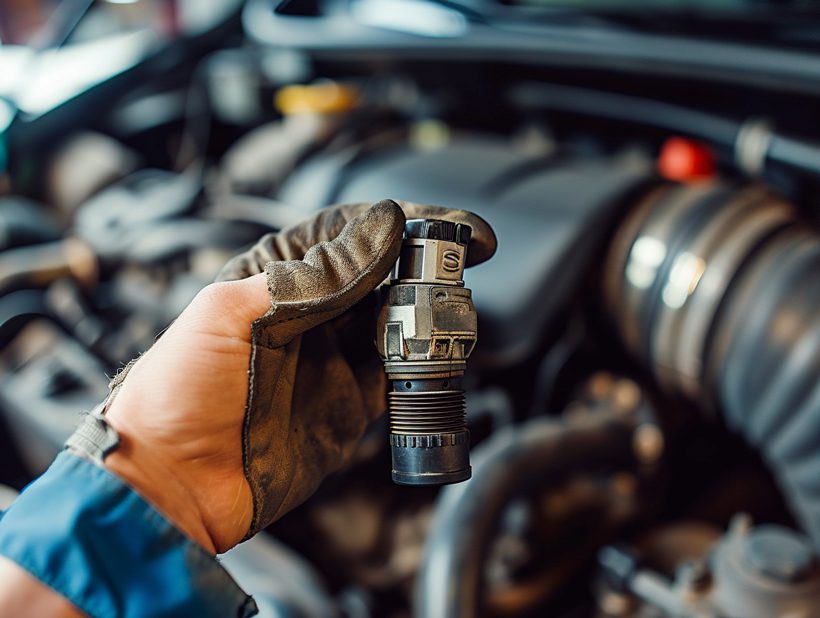Replacing an oxygen sensor, or O2 sensor, is a task that can seem daunting, but with the right approach, it’s something you can handle on your own. I’ll guide you through the signs that it’s time to replace your O2 sensor, and the tools you’ll need for the job.
Signs that it’s time to replace your O2 sensor
Knowing when to replace your oxygen sensor is crucial for maintaining your vehicle’s performance and fuel efficiency. Think of the O2 sensor as a vital component that communicates with your car’s computer to optimize combustion. Here’s how I determine if it’s time for a replacement:
- Check Engine Light: The most common sign is the illumination of the check engine light on your dashboard. While this light can indicate various issues, a diagnostic check can reveal if the O2 sensor is the culprit.
- Engine Performance Issues: If you’re experiencing irregular engine idling, sudden stops, or a general decrease in performance, the O2 sensor might be failing.
- Fuel Consumption: A faulty O2 sensor can lead to improper fuel-air mix, causing your car to consume more fuel than usual.
- Failed Emissions Test: If your vehicle fails an emissions test, it’s often an indication that the O2 sensor is not adequately monitoring the exhaust gases.

To further illustrate, here’s a breakdown of related issues that might occur due to a failing O2 sensor:
| Issue | Likely Symptom |
|---|---|
| Fuel Mixture Problems | Increased Fuel Consumption |
| Inadequate Combustion | Rough Engine Idle |
| Incomplete Catalytic Converter Burn | High Emission Levels |
| Impaired Feedback to Engine Computer | Hesitation or Stalling on Acceleration |
After identifying these signs, I’ll typically inspect the oxygen sensor and its wiring visually to confirm wear or damage. It’s essential to address these issues promptly, as a malfunctioning O2 sensor can lead to more serious problems like a damaged catalytic converter, which can be costly to fix. Remember, the integrity of the O2 sensor directly affects the health of your engine and the environment. Regular checks are a part of responsible vehicle maintenance.
Tools you’ll need for the job

When it comes time to replace your oxygen sensor, having the right tools on hand is essential for a smooth and successful job. Before you begin, make sure you’ve gathered all the necessary equipment. I’ve learned from experience that being well-prepared can save you a lot of time and frustration.
- High-Quality OBD II Scanner: This will help you confirm the O2 sensor issue and possibly pinpoint which sensor needs replacing.
- Oxygen Sensor Socket: A specialized socket that makes it easier to remove and install the sensor without causing damage.
- Socket Wrench: A trusty wrench is needed for leverage when using the oxygen sensor socket.
- Breaker Bar: For those sensors that are extra stubborn, a breaker bar provides additional torque.
- Penetrating Oil: Applying this a few hours before starting your work will help loosen the sensor, especially if it’s rusted in place.
Alongside these specialized tools, it’s a good idea to have a set of standard mechanic’s tools like screwdrivers, pliers, and a multimeter. These may come in handy for accessing the sensor or dealing with any unexpected challenges. Safety equipment is also crucial‚ÄîI always make a point of wearing protective gloves and safety glasses to prevent any injuries.
With all the tools laid out, I’m ready to tackle the job at hand. I always remind myself to be patient when loosening the O2 sensor. It can be a bit of a hassle if it’s been sitting there for a long time. I’ll ease it out gently, conscious not to strip the threads or damage the sensor housing, as that could make things worse. The process requires a delicate balance of persistence and care to ensure everything goes smoothly.
Next, it’s all about installing the new sensor‚Äîsecuring it snugly in place without over-tightening, which might cause a whole new set of issues. Patience is certainly a virtue when it comes to maintenance of this sort.
Locating the O2 sensor in your vehicle
When it’s time to tackle replacing your oxygen sensor, the first step is figuring out where it’s situated in your vehicle. O2 sensors can typically be found in two main locations: either before (upstream) or after (downstream) the catalytic converter. Most cars will have at least one upstream sensor near the exhaust manifold and a downstream sensor located near the back of the catalytic converter.
Here’s how you can find the O2 sensor:
- Consult Your Owner’s Manual: This should be your initial go-to resource. The manual often provides the exact locations of the sensors.
- Visually Inspect the Exhaust System: Put on your safety gear and slide under the car. Follow the exhaust pipe from the exhaust manifold down to the catalytic converter. Look for small, plug-like devices screwed into the exhaust pipe.
- Use an OBD II Scanner: If you have a scanner, it can help identify the sensor’s location by reading the trouble codes which typically indicate which sensor is experiencing issues.

Remember that some vehicles may have more than one oxygen sensor, so there might be additional sensors to locate. Car models produced after the mid-90s generally have multiple O2 sensors, both upstream and downstream versions, to meet emissions regulations. Here’s a quick glance at the potential number of sensors based on the type of vehicle:
| Engine Configuration | Typical Number of O2 Sensors |
|---|---|
| Inline 4-cylinder | 2 to 4 |
| V6 | 3 to 4 |
| V8 | 4 to 6 |
If you’re not keen on getting your hands dirty, a trustworthy mechanic can quickly point out the locations for you. Just remember, once you’ve determined where your O2 sensors are, make sure you’ve got all the necessary tools on hand before you start the replacement process. Patience is key here‚Äîrushing could lead to stripped threads or broken sensors, so take your time and handle the sensors with care.
Removing the old O2 sensor
Once you’ve figured out where the oxygen sensor is located, it’s time to roll up your sleeves and get to work. I’d like to stress that the engine and exhaust should be cool before you attempt removal to avoid the risk of burns‚Äîtrust me, it’s a precaution you’ll want to take.
Begin by disconnecting the negative battery cable. This step is crucial to prevent any electrical shocks or issues as you work. From there, you’ll need to locate the sensor’s wiring harness. Gently unplug the harness from the sensor; this might require some gentle twisting or the use of a flathead screwdriver.
Here’s what you’ll want to have on hand for a smooth removal process:
- Your trusty Oxygen Sensor Socket
- A dependable Socket Wrench
- A sturdy Breaker Bar for added leverage
First, place the oxygen sensor socket onto the sensor. By integrating the socket with your socket wrench, you can now attempt to turn the sensor counterclockwise. If the sensor’s being particularly stubborn, which they often can be after withstanding high temperatures and corrosion, that’s when your breaker bar comes in handy. Attach it to the socket wrench to give you the leverage needed to break the sensor free.

Sometimes, sensors won’t budge at first. Don’t be discouraged. Apply penetrating oil around the sensor’s base, let it soak in to loosen the corrosion, and try again after a few minutes.
Once the old sensor is removed, it’s a good idea to quickly compare it with the new one to ensure they match. Check the threading and the connector for compatibility before proceeding.
Remember that patience is key. Rushing the process can lead to stripped threads or damage to the exhaust system, which could add to your workload—and not in a good way. Satellite the tough spots, apply more penetrating oil if needed, and keep a steady hand as you work.
Armed with the right tools and a calm, methodical approach, you’ll have that old oxygen sensor out before you know it.
Installing the new O2 sensor
Once the old O2 sensor is successfully removed, it’s critical to move forward with a cautious and informed approach to installing the new one. To ensure a smooth installation process, I always follow these steps, and I recommend you do the same:
- Prepare the New Sensor: Before fitting the new O2 sensor, I make sure it’s identical to the old one. This includes verifying the connector type and the length of the sensor’s wire.
- Thread It By Hand: First, I thread the new sensor into place by hand to prevent cross-threading. Cross-threading can cause serious damage and lead to exhaust leaks, so I take extra care during this step.
- Tighten to Specification: Using a torque wrench, I tighten the sensor to the manufacturer’s specified torque. If the specifications are not handy, a good rule of thumb I use is to go a half-turn past hand tight‚Äîthis usually suffices.
- Reconnect the Wiring Harness: After the sensor is secured, I meticulously reconnect the wiring harness, ensuring it’s free of tension or kinks.
- Reattach the Battery Cable: Finally, with the sensor fully installed and wires connected, it’s time to reattach the negative battery cable.
Here are some additional tips to remember that I’ve picked up over the years:
- Apply anti-seize compound to the threads of the new O2 sensor if it doesn’t come pre-coated. This prevents seizing if the sensor needs to be removed in the future.
- Avoid getting any contaminants on the sensor tip, as it could impair its function.
- Double-check for any obstructions or contact points that could potentially damage the sensor or wiring once the vehicle is running.
Each step is designed not only to make the task at hand easier but to ensure that the new sensor operates correctly and efficiently. With the right technique, replacing an oxygen sensor is a manageable DIY task that can save you time and money. And remember, it’s all about precision and avoiding shortcuts that could lead to more complex problems down the road.
I often compare the process of installing a new oxygen sensor to surgery‚Äîeach movement must be considered, deliberate, and done with a clear understanding of what’s at stake. One wrong twist or forceful push, and you might find yourself back at square one‚Äîor worse, facing an entirely new set of automotive troubles.
Tips for a successful O2 sensor replacement

Replacing an oxygen sensor in your car can appear daunting, but proper preparation and care can make the process smoother and prevent common mistakes. I’ve gathered a few key tips that I’ve learned over the years that should help you as you tackle this task.
Ensure Vehicle is Cold: Always let your vehicle cool down before attempting to replace the O2 sensor. This reduces the risk of burns and stripping the threads on the exhaust system due to heat expansion.
Diagnose Correctly: Before you begin, make sure it’s indeed the O2 sensor that’s faulty. This can save you time and money from replacing parts unnecessarily.
Use the Correct Tools: Employing the proper tools is crucial. An O2 sensor socket set can help avoid damaging the sensor or surrounding components.
Avoid Contaminants: Your hands may contain oil or dirt, so handle the new sensor with clean gloves or a cloth. Even the smallest contaminants can impair sensor performance.
During the installation:
- Thread the new sensor by hand initially to prevent cross-threading.
- Use a torque wrench for the final tightening to meet the manufacturer’s specifications.
- Double-check all electrical connections are secure; this ensures there are no false readings or malfunctions post-installation.
- After installation, I always recommend using a code reader to ensure the engine control unit no longer detects any issues with the oxygen sensor system.
Remember to reset your vehicle’s ECU after installing the new sensor. Disconnecting the battery for a short period or using a scanner can do this. By resetting, the ECU will re-adjust to the new sensor’s readings, leading to better performance and more accurate emissions monitoring.
By following these tips and proceeding with care, you’ll be equipped to replace your O2 sensor effectively, maintaining your car’s health and ensuring it runs efficiently. While there might be temptations to rush the process, recognize that accuracy is pivotal in the repair of automotive electronics. A methodical approach not only guarantees a job well done but also instills a deeper understanding of your vehicle’s intricate systems.
Conclusion
Tackling an oxygen sensor replacement can feel daunting but with the right approach, it’s a task you can confidently handle. Remember, precision and patience are your best tools when working on your vehicle’s electronics. By following the steps I’ve shared, you’ll ensure that your car runs efficiently and that you’ve saved on potentially costly mechanic fees. Don’t forget to perform a final systems check to confirm everything is operating smoothly. Armed with these tips, you’re now ready to take on the challenge and get your car back to peak performance.
